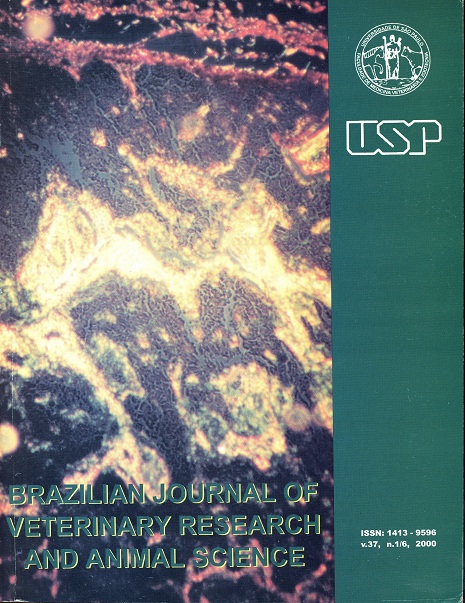Natural Trichostrongyloidea Cram, 1927 infections in deer (Mammalia: Cervidae) from the States of Mato Grosso do Sul and São Paulo
DOI:
https://doi.org/10.1590/S1413-95962000000200012Keywords:
Helminths, Trichostrongylidae, CervidaeAbstract
From 1985 to 1996, 42 deers (seven Mazama americana, 16 M. gouazoubira, 13 Ozotoceros bezoarticus and six Blastocerus dichotomus) were submitted to necropsy. From those animals, 14,426 Trichostrongyloidea nematodes were gathered, being 13,281 (92.05%) parasites of abomasum and 1,145 (7.95%) parasites of small intestine. Haemonchus contortus, H. similis, Trichostrongylus axei, T. colubriformis, Cooperia punctata and C. pectinata were identified in those organs. All of the animals had helminthic infections by one or more worm species, occurring a wide variation in the intensity of infection (from one to 4,345 nematodes). The results showed low intensity of infection values, less than 100 worms, in 25 (59.52%) of the animals. The higher results of mean intensity of infection were observed in M. gouazoubira (596.37) and in O. bezoarticus (331), and the lower results, in M. americana (17.57) and B. dichotomus (75.5). The most expressive values of intensity of infection, abundance and prevalence were observed for Haemonchus spp (fourth stage larvae - L4), H. contortus, H. similis and T. axei. Genus Haemonchus was verified in 35 animals, and, therefore, with a prevalence of 83.33%; the total intensity of infection of this genus was 11,616 specimens, representing 80.52% of the Trichostrongyloidea nematodes verified, being that the majority (8,903) of those worms were constituted of young forms. Otherwise, H. similis was the specie predominating in the infections and, therefore, the one that showed the highest value of abundance. Genus Trichostrongylus was verified in 24 (57.14%) animals, and the total intensity of infection was 2,444 specimens, being 1,655 specimens of T. axei, that represented 11.54% of the parasitic burden observed. The six worm species observed in deers are also common to domestic ruminants in the states of São Paulo and Mato Grosso do Sul, and, in this way, none species of Trichostrongyloidea exclusive to deers was observed.Downloads
Download data is not yet available.
Downloads
Published
2000-01-01
Issue
Section
VETERINARY MEDICINE
License
The journal content is authorized under the Creative Commons BY-NC-SA license (summary of the license: https://
How to Cite
1.
Nascimento AA do, Bonuti MR, Mapeli EB, Tebaldi JH, Arantes IG, Zettermann CD. Natural Trichostrongyloidea Cram, 1927 infections in deer (Mammalia: Cervidae) from the States of Mato Grosso do Sul and São Paulo. Braz. J. Vet. Res. Anim. Sci. [Internet]. 2000 Jan. 1 [cited 2026 Jan. 16];37(2):153-8. Available from: https://revistas.usp.br/bjvras/article/view/5837





